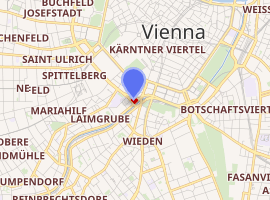Secession Building
The Secession Building (German: Wiener Secessionsgebäude) is an exhibition hall built in 1898 by Joseph Maria Olbrich as an architectural manifesto for the Vienna Secession, located in Vienna, Austria.[1] Secession refers to the seceding of a group of rebel artists from the long-established fine art institution.
| Secession Building | |
|---|---|
Wiener Secessionsgebäude | |
Secession Building, Vienna, Austria | |

| |
| General information | |
| Type | Exhibition pavilion |
| Architectural style | Art Nouveau |
| Location | Vienna, Austria |
| Coordinates | 48°12′1.86″N 16°21′56.43″E |
| Construction started | 1897 |
| Completed | 1898 |
| Dimensions | |
| Diameter | 40 m × 30 m (131 ft × 98 ft) |
| Technical details | |
| Floor area | 1,000 m2 (11,000 sq ft) |
| Design and construction | |
| Architect | Joseph Maria Olbrich |
| Other designers | Koloman Moser, Gustav Klimt |
| Website | |
| www | |
Description
The building features the Beethoven Frieze by Gustav Klimt,[2] one of the most widely recognized artworks of Secession style (a branch of Art Nouveau, also known as Jugendstil in Germany and Nordic countries). The building was financed by Karl Wittgenstein,[3] the father of Ludwig Wittgenstein.
The motto of the Secessionist movement is written above the entrance of the pavilion: "To every age its art, to every art its freedom" (German: Der Zeit ihre Kunst. Der Kunst ihre Freiheit). Below this is a sculpture of three gorgons representing painting, sculpture, and architecture.
The building has been selected to figure on the national side of the €0.50 Austrian coin. It also appears as the main motif of one of the Austrian gold collectors' coins: the 100 euro Secession commemorative coin, minted in November 2004, on the obverse side. The reverse depicts a detail from the Beethoven Frieze, which is housed in the building.
Gallery
 Secession Building façade
Secession Building façade- Foliage work detail
 Jugendstil owls on the façade by Koloman Moser
Jugendstil owls on the façade by Koloman Moser_-_5987_-_%C3%96sterreichische_Galerie_Belvedere.jpg) The Beethoven Frieze, created by Gustav Klimt, is housed in the lower floor.
The Beethoven Frieze, created by Gustav Klimt, is housed in the lower floor. Painting, Architecture, and Sculpture
Painting, Architecture, and Sculpture
References
- Secession hall official web site: The Building Archived 2008-10-26 at the Wayback Machine
- Secession hall official web site: The Beethoven Frieze
- Monk, Ludwig Wittgenstein: The Duty of Genius: p.8
| Wikimedia Commons has media related to Secession Building, Vienna. |